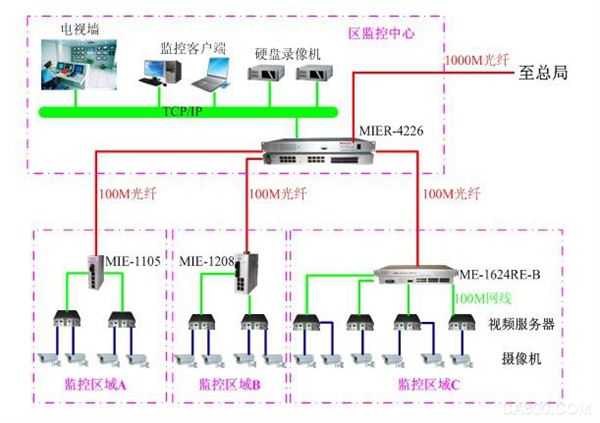The intelligent traffic road video surveillance system, through the establishment of a surveillance network covering major urban arterial roads and traffic intersections, is equipped with corresponding image monitoring equipment and software to enable real-time transmission of traffic conditions at traffic intersections to the monitoring center to monitor the running status of road vehicles. Communication technology occupies a very important position in the intelligent transportation industry. Traditional long-distance monitoring and image transmission generally use a large number of video lines or video optical transceivers for transmission. This is easily subject to terrain and other conditions, and has a large application and promotion. Obstacles. At present, intelligent traffic monitoring makes full use of very mature Ethernet technology to transmit video, audio, and various information via Ethernet to achieve various effective monitoring solutions. First, the demand This plan provides the city's main roads and intersections with network monitoring systems for traffic roads. When the entire system is completed, it can realize real-time monitoring of the monitoring points at the regional traffic monitoring centers. The monitoring data of the traffic monitoring centers of the regional centers will be transmitted to the monitoring center of the General Administration of Transportation of China to realize the real-time monitoring of the monitoring points at the traffic monitoring centers of the regional centers and the monitoring centers of the General Administration of Communications. Second, the system structure According to the actual needs of intelligent traffic monitoring, controllable cameras or fixed cameras are installed in key areas such as city main roads and traffic intersections. The video server is used to convert the video signal of the camera into a TCP data packet, and the data is transmitted to the monitoring center through an industrial Ethernet switch to realize a video monitoring system based on the network platform. The video surveillance system can be divided into three parts: monitoring area, transmission network and monitoring center. 1. Monitoring area The surveillance area is mainly composed of front-end cameras, video servers, and industrial Ethernet switches. Due to the advanced H.264 image compression standard, the bandwidth occupied by each video in the network is low and the image is clear. At the same time, due to the use of industrial Ethernet switches, the stability of the network system can be guaranteed. It is suitable for the transportation industry's high real-time, high-definition, and stable transmission requirements. 2. Transmission network The transmission network of the video surveillance system adopts the standard TCP/IP protocol and can be directly operated on the intranet of the transportation department. The video signal of the front-end camera is transmitted to the industrial Ethernet switch through the network using a network video server, and transmitted to each area monitoring center using the fiber interface of the switch. 3. Monitoring Center The monitoring system adopts the Client/Sever structure and installs the center video monitoring system server in the monitoring center. This system cooperates with each monitoring area to complete on-site image processing. In the monitoring center, the video surveillance system server restores digital video to analog images and transmits the images to the command center TV wall. The command and dispatch personnel can also choose to use the computer as the monitoring terminal to centrally call and monitor all monitoring information. In addition, the user can use any computer on the network as a monitoring client, and use the client's Web browser to view the required screen anytime, anywhere. Can achieve real-time multi-screen monitoring, remote control camera PTZ, and illegal capture and other operations. Third, the system topology Fourth, transmission equipment selection In different monitoring areas, choose to use different switching devices, such as using 5-port or 8-port switches in a few areas of the video server, and using 16- or 24-port switches in areas with a large number of video servers and using the switches' optical fibers. The interface uses a special optical cable to transmit to the district monitoring center. The data is aggregated by the MIER-4226 all-optical port fiber switch and transmitted to the hard disk recorder and video wall by the 1000M network interface of the MIER-4226 switch. The transmission to the General Administration of Communications is implemented using the 1000M fiber interface of the MIER-4226. summary: The use of a video server not only makes it easy to set up various types of monitoring networks, but it can be very convenient when the monitoring system needs to be upgraded. It only requires a few more devices to implement the upgrade without any impact on the existing system. In addition, the central management software enables the host to monitor and manage multiple video servers, facilitating the establishment of large-scale video surveillance systems. Island Freezer,Island Display Freezer,Kitchen Island Freezer,Supermarket Island Freezer ZHENGZHOU KAIXUE COLD CHAIN CO., LTD. , https://www.supersnowfreezer.com